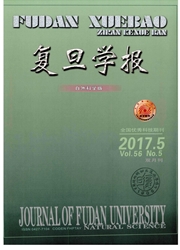

 中文摘要:
中文摘要:
介绍了一种基于差分光学吸收光谱技术对上海城市大气中HCHO和CHOCHO进行高时间分辨率的测定方法。针对HCHO和CHOCHO的不同吸收结构,选择适当的光谱分析波段,扣除干扰气体的吸收,有效降低残差,得到了用于反演目标气体的光学厚度,并进一步获得2013年10月HCHO与CHOCHO的浓度变化特征。HCHO,CHOCHO平均浓度分别为(4.0±1.6)和(3.4±1.2)μg·m^-3。受人为源的影响,HCHO工作日平均浓度高于假期平均浓度,而CHOCHO的浓度相差不大。两者浓度的日变化趋势相似,早晨06:00—07:00出现最大值后迅速下降,到09:00左右出现最小值后又缓慢上升,并在夜间至日出前保持相对稳定的浓度水平。为探索大气HCHO可能的来源和生成过程,选取夜间稳态阶段,早高峰阶段,光化学反应阶段和晚高峰阶段等四个典型时段对HCHO的来源进行解析。NO2作为HCHO的一次源指示物;同时作为光化学反应的中间产物,HCHO和CHOCHO生成机理具有相似性,因此以CHOCHO作为解析HCHO的二次源指示物,利用线性回归模型来源解析结果所得HCHO浓度与实际观测值具有较好的相关性,相关系数r为0.60~0.81,分析得出上海城区二次来源对环境HCHO浓度的贡献约为三分之一。
 英文摘要:
英文摘要:
This paper proposes a method to monitor atmospheric HCHO and CHOCHO with high temporal resolution based on differential optical absorption spectroscopy(DOAS) in Shanghai urban area.Based on the characteristic absorbing structure of HCHO and CHOCHO,different fitting intervals were chosen for spectral analysis in order to avoid the absorption of interfering gases and reduce the residuals of spectral analysis.The resulting optical thickness of the target gas is used to obtain HCHO and CHOCHO concentrations,which were averaged at(4.0+1.6) and(3.4±1.2) μg· m^-3 in October 2013,respectively.The averaged concentrations of HCHO in workdays were higher than those in holidays due to the impacts of its anthropogenic emission sources,while no obvious differences of averaged CHOCHO concentrations between workdays and holidays were observed.Diurnal patterns of HCHO and CHOCHO were alike.In the early morning,both the HCHO and CHOCHO concentrations peaked at 06:00—07:00,and then decreased rapidly to the minimum around 09:00.Afterwards,the concentrations increased continuously until sunset and kept in a relatively stable level in the evening.To explore the possible emission source and formation mechanism of atmospheric HCHO,four typical periods,i.e.steady-state stage at night,morning rush hours,photochemical reaction stage and evening rush hours,were classified for source apportionment N02 is regarded as the indicator for primary source of ambient HCHO.As the intermediate products of photochemical reactions,HCHO has a similar formation mechanism in common with CHOCHO.Therefore,it is reasonable to use CHOCHO as an indicator for secondary source of ambient HCHO.The linear regression analysis showed a good agreement between modeled and observed HCHO concentrations,the correlation coefficients R^2 ranged from 0.60 to 0.81.Secondary sources of HCHO were estimated to contribute to one third of ambient HCHO concentrations in Shanghai urban area
 同期刊论文项目
同期刊论文项目
 同项目期刊论文
同项目期刊论文
 Remote sensing of NO2 emission from the central urban area of Shanghai (China) using the mobile DOAS
Remote sensing of NO2 emission from the central urban area of Shanghai (China) using the mobile DOAS 期刊信息
期刊信息
